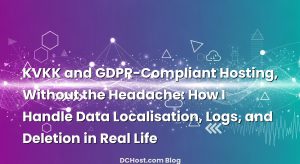So there I was, staring at a quiet monitoring dashboard on a rainy Tuesday, sipping a lukewarm coffee, when a client pinged me with that message you never want to see: “Are we safe if the primary region goes down?” We’d been talking about backups for weeks, but what they really wanted was the comfort of knowing their files—their app’s lifeblood—would still be reachable even if one region blinked off the map. That’s when it hit me (again): cross‑region replication isn’t a nice‑to‑have anymore. It’s the seatbelt. You hope you don’t need it, but when you do, you want it buckled and tested.
Ever had that moment when a single object, a customer contract or a product image, suddenly matters more than anything else—and you realize it’s in only one place? This is where S3‑compatible storage, whether on AWS S3 or MinIO, really shines. With versioning, replication, and a clean plan for failover, you can sleep without the 3 a.m. “what if” spinning in your head. In this guide, I’ll walk you through cross‑region replication on S3/MinIO, why versioning is the unsung hero, how to think about failover without panic, and the practical DR runbook I actually use. My goal: help you run a drill today, so you’re calm when the storm shows up tomorrow.
İçindekiler
- 1 The Core Idea: Two Buckets, One Truth (But Many Versions)
- 2 How Cross‑Region Replication Really Works (Without the Sales Gloss)
- 3 Versioning: The Safety Net That Quietly Saves Your Day
- 4 MinIO vs S3: Same Language, Different Accents
- 5 Failover Without Drama: DNS, Endpoints, and the Human Switch
- 6 A Practical DR Runbook You Can Copy and Make Your Own
- 7 The Real‑World Gotchas (And How to Disarm Them)
- 8 Monitoring, Alarms, and the Art of Boring Dashboards
- 9 Tying It All Together With the Rest of Your Stack
- 10 A Field‑Tested DR Runbook (Step‑by‑Step)
- 11 A Few Stories From the Trenches
- 12 What Good Looks Like
- 13 Wrap‑Up: Make It Boring, Make It Real
The Core Idea: Two Buckets, One Truth (But Many Versions)
Let’s warm up with a simple picture. Think of your primary bucket as the main library in town. Every time you upload a new object, it’s like shelving a new book. Cross‑region replication is the intercity shuttle that brings a copy of that book to the library across town. If something happens to Library A, Library B still has your shelves covered. The trick is doing that reliably, securely, and in a way that doesn’t leave you wondering which shelf has the latest edition.
Here’s the thing most teams miss at first: replication without versioning is just cloning today’s state and pretending yesterday never happened. That’s how you lose old drafts, or worse, get stuck with a silent overwrite. Turn on versioning first. On AWS S3, it’s a checkbox. On MinIO, it’s a bucket setting. After that, every change becomes a new version, and delete operations leave a special marker instead of actually shredding your data history. That delete marker is like putting a curtain in front of the book—it’s not visible anymore, but it’s still behind the curtain unless you intentionally remove it.
In my experience, versioning is what takes cross‑region replication from “maybe helpful” to “we’re covered.” It lets you undo user mistakes, roll back botched deployments that touched object metadata, and recover from those single moments of panic when you realize the wrong directory was synced. If you take one action after this article, make it this: flip on versioning before you do anything else.
How Cross‑Region Replication Really Works (Without the Sales Gloss)
On a high level, replication follows a simple rule: when a new object lands in your source bucket, a replication task ships it to the destination bucket in another region, often on the same platform but not necessarily. With AWS S3, you configure a replication rule and a role with permission to write to the target. On MinIO, you connect clusters and create replication rules at the bucket level. The details matter—encryption, prefixes, tags, and even whether delete markers should replicate—but the pattern is familiar. For a deeper dive, AWS has a solid primer in their replication documentation, and MinIO explains their approach clearly in their server‑side replication guide.
I tend to think in three simple shapes: one‑way replication (Primary → Secondary), two primaries both replicating to each other (bi‑directional), and a slightly stricter form of active/passive where the passive end is read‑mostly until a failover event. Each has tradeoffs. One‑way is simple and sturdy but requires a deliberate cutover if the primary fails. Bi‑directional gives you local write performance in both regions but demands discipline—clients must avoid writing the same path in both places at once or you can create version conflict noise. And the active/passive pattern is comforting because it makes the “who writes where” question easy: all writes go to one place until you flip a switch during failover.
Whichever shape you choose, keep your replication rules boring. Scope them by prefix or tag if you must, but start broad. It’s tempting to get clever and replicate “just the important stuff.” I’ve never seen that end well during an incident. The file you didn’t think you needed is the one someone asks for as you’re flipping DNS.
Versioning: The Safety Net That Quietly Saves Your Day
Versioning can feel like housekeeping until you meet your first “oops” moment. I once watched a team push an automation that updated a set of object metadata. It ran perfectly—on the wrong prefix. Versioning saved them. We rolled back the affected versions in minutes, and because replication also moves versions, the other region recovered just as quickly.
Three things to keep in mind with versioning. First, a delete is not really a delete; it’s a delete marker on top of the stack. You can choose to replicate that marker or not. In highly protected environments, you might not replicate deletes until after a retention period. Second, object lock (sometimes called WORM) can enforce retention; on S3 it’s built‑in object lock, and on MinIO you can configure similar retention policies. AWS explains object lock mechanics nicely in their Object Lock guide. Third, lifecycle rules and replication rules intersect—be careful about expiring old versions on the source if you still need them on the destination for compliance or investigations.
When you enable versioning on day one, replication just becomes the courier. It carries not only your current state, but also your ability to rewind. And when a failover occurs, it’s not just that your files exist somewhere else—it’s that your file history lives there too.
MinIO vs S3: Same Language, Different Accents
I’ve had teams running both: S3 in one region, MinIO on bare‑metal or VPS in another. The cool part is that the S3 API is the common language. The accents show up in configuration. On S3, you’ll define replication configurations with IAM roles and might use different KMS keys per region. On MinIO, you typically connect clusters and apply bucket‑level replication with MinIO’s tooling. If you’re going deeper with MinIO, I wrote up a practical path to a production‑ready setup in how I build MinIO for production with erasure coding, TLS, and clean bucket policies.
A subtle difference you’ll feel in real life is where and how you see replication lag and errors. On S3, CloudWatch and replication metrics will tell you what’s queued and what’s failing. On MinIO, you’ll lean on its Prometheus metrics and logs. Either way, make it visible. The secret to a confident failover is knowing your replication backlog in minutes, not guessing by “it seems fine.”
Failover Without Drama: DNS, Endpoints, and the Human Switch
Everybody wants “automatic” failover until they try to untangle a bad automation at 2 a.m. My rule of thumb: automate the mechanics, keep the decision human. In other words, let your replication and health checks run all day, but require a deliberate action to switch the traffic. Good DNS is your friend here. You can use geo‑routing or weighted records to steer reads toward the healthiest endpoint, and in a pinch, flip a single record to move traffic from Primary to Secondary.
If you want a friendly primer on the bigger picture of multi‑region architectures, I walked through practical patterns in my guide to multi‑region architectures with DNS geo‑routing and data replication. And if the DNS part makes your stomach clench, I also documented a surprisingly calm approach to multi‑provider DNS using octoDNS in how I run multi‑provider DNS with octoDNS. The secret sauce is not fancy automation; it’s having a tested, repeatable switch that takes seconds, not minutes, and doesn’t require three different people to approve.
But wait, there’s more. Your application’s relationship to object storage matters. If your app uses pre‑signed URLs, you need a way to generate them against the right endpoint during failover. If your app is S3 endpoint agnostic, life’s easier—you change a base URL and you’re done. If you’ve hardcoded endpoints in half a dozen lambdas and a cron job no one remembers owning, today’s the day to reconcile that. Centralize the endpoint in config or a feature flag so you can flip it with one change.
A Practical DR Runbook You Can Copy and Make Your Own
Pre‑work: Set the Stage Before Anything Breaks
First, enable versioning on both buckets. This is non‑negotiable. Second, create a replication rule from your primary to your secondary. Start with broad scope and default behaviors—replicate new objects and relevant metadata. Third, confirm your encryption story. If you use managed keys in one region and different keys in another, test reading replica objects with your application in both places. Fourth, decide whether delete markers replicate. If your compliance posture requires a cooling‑off period before deletes appear in the secondary, plan it now; don’t decide during an incident. Fifth, expose metrics to your monitoring: replication lag, errors, and the count of pending operations. You’ll need that visibility later.
Then, design your failover mechanism. Choose a DNS strategy that lets you switch endpoints fast without accidentally creating a split‑brain scenario. I like a single CNAME for the object endpoint that I can point at either region. Practice changing it. Don’t wait until a real failure to discover your DNS TTL is three hours and your registrar adds a mysterious delay. And while you’re at it, document how your app creates pre‑signed URLs or references the S3 endpoint. A single source of truth—an env var, config file, or parameter store—keeps you from chasing references.
Finally, do a dry run. Script a tiny set of objects—say, a test prefix—and replicate them. Read them from both regions with the same code path your app uses. Then simulate a failover by pointing your app at the secondary. Fix what breaks. Repeat until it’s boring. Boring is the goal.
Failover: The Calm Switch
Here’s how I structure the actual move when the primary stumbles. Step one: acknowledge the incident and freeze risky changes. If possible, gate or pause writes at the app layer for a moment while you assess. Step two: check replication lag. If it’s minimal, proceed; if it’s growing and you’re missing critical files on the secondary, consider a targeted sync for hot paths. Step three: flip the object endpoint. This is your DNS change or config flag. Step four: validate reads from the secondary with your app’s normal flow—grab a few known objects, especially from prefixes that change often.
If you’re bi‑directional, now you must decide whether the secondary accepts writes. If yes, you’re officially in a two‑writer scenario. That can work if you’ve designed for it, but you’ll want to steer client writes to the secondary deliberately and make sure the primary does not silently resume accepting writes in the background. If you’re active/passive, keep writes in the secondary until you’re ready to fail back. Either way, document exactly when and who turned writes back on, and where.
Failback: Returning the Crown to the Primary
Failback is where many teams trip. The secondary has been happily serving traffic; now the primary is healthy again. Do you mirror everything back? Do you trust replication to catch up? My approach: treat failback like a new migration. Step one: ensure replication from secondary to primary is either temporarily enabled or you run a one‑time sync for the changed prefixes. Step two: verify a clean state with spot checks and your own inventory. Step three: flip the endpoint back to the primary with the same discipline you used during failover. Step four: remove or tighten temporary rules you opened while in failover mode. The last thing you want is a lingering two‑way path when you think you’re back to single‑writer mode.
The Real‑World Gotchas (And How to Disarm Them)
Every system has quirks, and object storage is no exception. Replication isn’t instantaneous. There’s always lag, usually small, occasionally not. Design your app to tolerate it. If your app requires read‑after‑write on the very object a user just uploaded, consider serving that object from the primary store that accepted the write (or cache it) until replication catches up. This is less about platform and more about expectations. The more your app can accept eventual consistency for cross‑region reads, the fewer midnight pages you’ll get.
Another surprise I’ve seen: encryption key mismatches. If you encrypt objects with one KMS key in Region A and a different one in Region B, that’s fine. But make sure your app has permission to read both. More than once, I watched a team fail over perfectly—only to be blocked by a permission error decrypting the very objects they’d replicated. Test with the app, not just with admin credentials.
Be mindful of existing data. Some platforms replicate only new objects after you enable the rule, not your entire historical archive. If you want to seed the destination, plan a bulk copy ahead of time and verify checksums. On S3, you may use batch operations; on MinIO, your toolkit might include a client‑side mirror operation for a one‑off warmup. Either way, let replication handle the ongoing trickle; use a bulk move for the big initial lift.
And yes, deletion policies matter. Decide whether delete markers replicate immediately or after a delay. In a stringent environment, I’ve seen teams keep deletes local for a period and rely on object lock or lifecycle policies to enforce retention. If your app expects hard deletes, you need to map that to versioned behavior and communicate it to the developers and support teams. Nothing causes more confusion than “I deleted it, why is it still there in the other region?”
Monitoring, Alarms, and the Art of Boring Dashboards
I love boring dashboards. A replication backlog line that hovers near zero is one of the most comforting sights in ops. Expose your replication metrics: total operations queued, failure rates, lag in seconds, and maybe a simple green/red “destination reachable” signal. If you’re on S3, you’ll find helpful metrics in the replication reports and events. If you’re on MinIO, wire up Prometheus and build a tiny panel just for replication health.
Set gentle alerts, not screamers. A backlog crossing a threshold should nudge you during the day, not wake you at night. Treat hard failures differently: a destination outage or sustained increase in failures deserves a louder bell. And don’t forget human drills. I like to run a 20‑minute tabletop once a quarter where we “pretend” to fail over, walk through the steps, and confirm names, credentials, and DNS controls are where we think they are.
Tying It All Together With the Rest of Your Stack
Object storage is one piece of the bigger DR story. Your databases need their own act—replication or regular, application‑consistent backups. If that part keeps you up at night, I’ve shared a friendly, practical walkthrough in how I take application‑consistent hot backups with LVM snapshots for MySQL and PostgreSQL. The nice thing is, when your database and your object store both have a cross‑region plan, your recovery conversations suddenly feel less scary—and a lot more doable.
If you’re building your own S3‑compatible cluster, don’t skip the fundamentals: erasure coding, TLS everywhere, and clear bucket policies that match your app’s access patterns. My write‑up on production‑ready MinIO on a VPS covers the pieces that make replication sit on a stable foundation. And if you want to sleep even better, combine your cross‑region story with a resilient DNS layer; I went deep on that in my octoDNS playbook and the broader patterns in multi‑region architectures with DNS geo‑routing.
A Field‑Tested DR Runbook (Step‑by‑Step)
Before the Storm
- Enable versioning on both buckets; verify a new object shows a version ID.
- Configure cross‑region replication; keep the initial rule simple and broad.
- Confirm encryption and permissions; test reads and writes from your app in both regions.
- Decide how deletes behave across regions; document the choice and teach your team.
- Create a DNS or config switch for the object endpoint; practice flipping it.
- Expose replication metrics; set friendly alerts.
- Warm the destination with a one‑time copy if you have a large historical archive.
When Primary Wobbles
- Pause risky writes if possible; announce the incident to the team.
- Check replication backlog; if it’s small, proceed; if large, sync hot prefixes.
- Flip your endpoint to the secondary via DNS or config.
- Validate critical reads in the app path; confirm pre‑signed URL generation if used.
- Make a deliberate decision about writes: single‑writer or allow writes in the secondary.
- Document the switch time and who approved it.
Stabilize
- Monitor error rates, replication status, and application logs.
- Communicate with stakeholders; give estimated recovery timelines.
- Clean up any temporary access changes you made under pressure.
Failback
- Re‑enable replication back to the primary or run a one‑time mirror of changed prefixes.
- Verify a clean state with checksums or spot checks.
- Flip the endpoint back to the primary.
- Turn off any temporary bi‑directional replication if you used it; return to your normal mode.
- Hold a 15‑minute retro while the details are fresh; update the runbook.
A Few Stories From the Trenches
One of my clients insisted on bi‑directional replication on day one. I cautioned them to start single‑writer and graduate later. They were confident; we set it up cleanly. During a small network flap, both regions accepted writes to the same path within a short window. Versioning saved them again—the conflict was visible and recoverable—but it still meant a tense hour unwinding user‑facing inconsistencies. They switched to a feature flag that chooses the active writer, and the rest of the year was blissfully quiet.
Another team did everything right except permissions on the secondary. During failover, their pre‑signed URLs were generated perfectly—but the key used by the app didn’t have permission to read from the destination bucket with that region’s encryption key. The test that would have caught it? Generating a pre‑signed URL from the app for the secondary and using it from a fresh client. We added that to their quarterly drill.
And on a happier note, I’ve seen teams rehearse this so well that a region outage ended up being a non‑event. They flipped a CNAME, traffic moved, and their support inbox stayed calm. That’s the level you can reach when replication is a steady hum in the background and your runbook is muscle memory.
What Good Looks Like
You’ll know you’re in a good place when a new teammate can run a mock failover by following your runbook without asking a dozen questions. When your monitoring tells you the replication backlog in seconds and the count of pending ops. When you can generate pre‑signed URLs for either region on command. And when your stakeholders hear “we practiced this” more than “we’re pretty sure.” It’s less about specific tooling and more about clarity, repetition, and a system designed to be boring.
Wrap‑Up: Make It Boring, Make It Real
If you’ve read this far, you already know: cross‑region replication isn’t just a box you check. It’s a small set of simple decisions made ahead of time—versioning on, rules set, permissions clean, DNS switch rehearsed—that add up to a calm day when something breaks. Whether you’re on AWS S3 or MinIO, the principles are the same. Keep the replication rules simple, treat versioning as your safety net, and practice the DR runbook until flipping regions feels like changing the song in your playlist.
My parting advice is straightforward. Turn on versioning. Set up a broad replication rule. Choose your failover switch and try it on a quiet afternoon. If you want more context on the broader multi‑region story, have a look at how I think about multi‑region architectures, and for the DIY crowd, the production‑ready MinIO playbook. Then brew a fresh coffee, run your drill, and take the rest of the day off. You’ve earned that calm dashboard.





